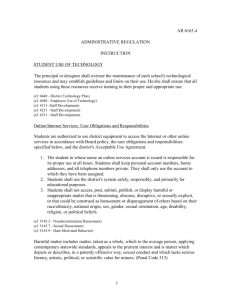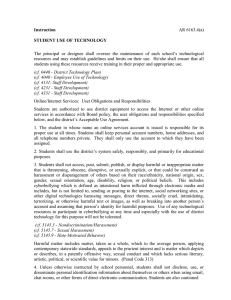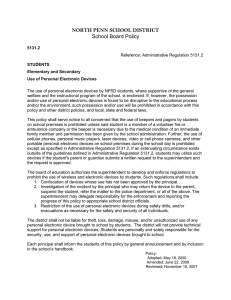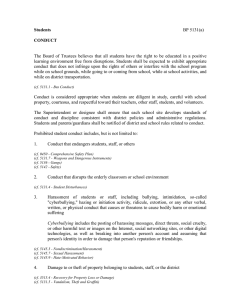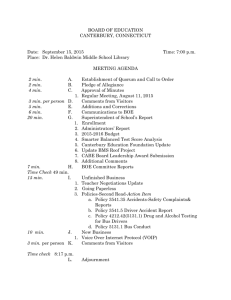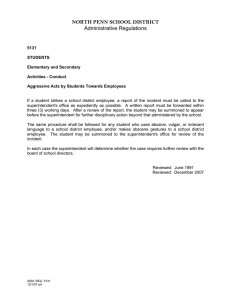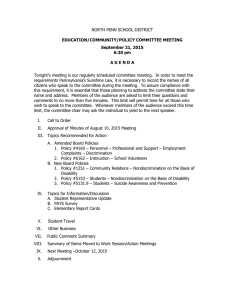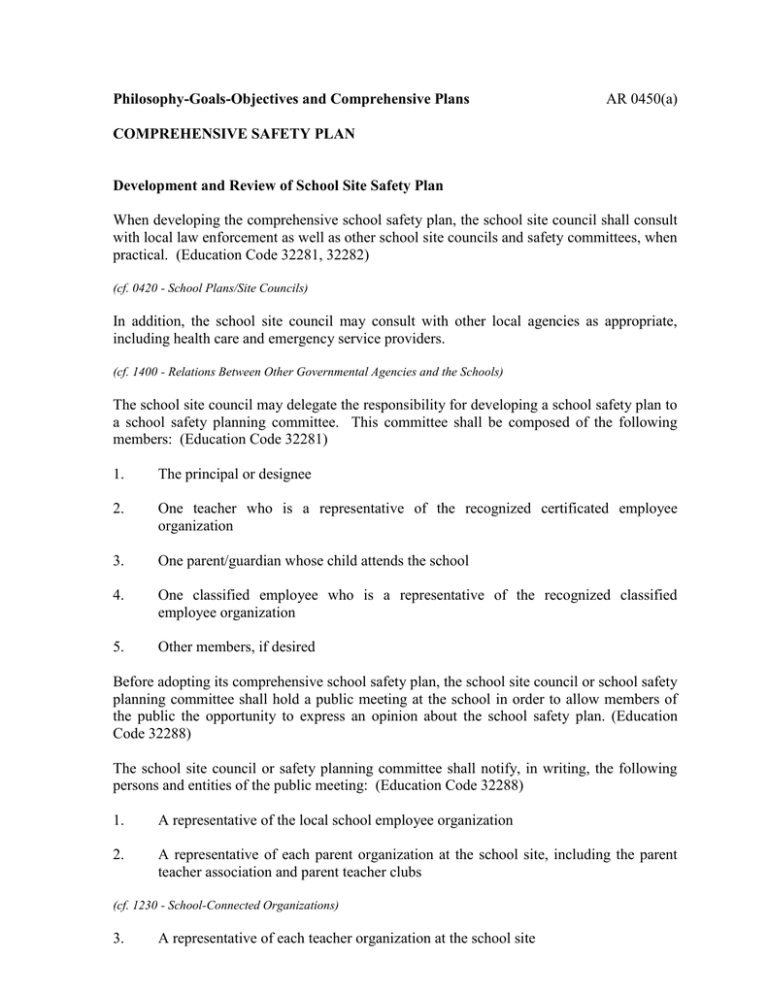
Philosophy-Goals-Objectives and Comprehensive Plans
AR 0450(a)
COMPREHENSIVE SAFETY PLAN
Development and Review of School Site Safety Plan
When developing the comprehensive school safety plan, the school site council shall consult
with local law enforcement as well as other school site councils and safety committees, when
practical. (Education Code 32281, 32282)
(cf. 0420 - School Plans/Site Councils)
In addition, the school site council may consult with other local agencies as appropriate,
including health care and emergency service providers.
(cf. 1400 - Relations Between Other Governmental Agencies and the Schools)
The school site council may delegate the responsibility for developing a school safety plan to
a school safety planning committee. This committee shall be composed of the following
members: (Education Code 32281)
1.
The principal or designee
2.
One teacher who is a representative of the recognized certificated employee
organization
3.
One parent/guardian whose child attends the school
4.
One classified employee who is a representative of the recognized classified
employee organization
5.
Other members, if desired
Before adopting its comprehensive school safety plan, the school site council or school safety
planning committee shall hold a public meeting at the school in order to allow members of
the public the opportunity to express an opinion about the school safety plan. (Education
Code 32288)
The school site council or safety planning committee shall notify, in writing, the following
persons and entities of the public meeting: (Education Code 32288)
1.
A representative of the local school employee organization
2.
A representative of each parent organization at the school site, including the parent
teacher association and parent teacher clubs
(cf. 1230 - School-Connected Organizations)
3.
A representative of each teacher organization at the school site
AR 0450(b)
COMPREHENSIVE SAFETY PLAN (continued)
(cf. 4140/4240 - Bargaining Units)
4.
A representative of the student body government
5.
All persons who have indicated that they want to be notified
In addition, the school site council or safety planning committee may notify, in writing, the
following entities of the public meeting: (Education Code 32288)
1.
A representative of the local churches
2.
Local civic leaders
3.
Local business organizations
(cf. 1220 - Citizen Advisory Committees)
(cf. 1700 - Relations between Private Industry and the Schools)
Content of the Safety Plan
The districtwide and/or school site safety plan shall include an assessment of the current
status of school crime committed on campus(es) and at school-related functions. (Education
Code 32282)
The plan also shall identify appropriate strategies and programs that will provide or maintain
a high level of school safety and address the school's procedures for complying with existing
laws related to school safety. The plan shall include the development of all of the following:
(Education Code 32282)
1.
Child abuse reporting procedures consistent with Penal Code 11164
(cf. 5141.4 - Child Abuse Prevention and Reporting)
2.
Routine and emergency disaster procedures including, but not limited to:
a.
Adaptations for students with disabilities in accordance with the Americans
with Disabilities Act
(cf. 0410 - Nondiscrimination in District Programs and Activities)
(cf. 6159 - Individualized Education Program)
b.
An earthquake emergency procedure system in accordance with Education
Code 32282
(cf. 3516 - Emergencies and Disaster Preparedness Plan)
(cf. 3516.3 - Earthquake Emergency Procedure System)
AR 0450(c)
COMPREHENSIVE SAFETY PLAN (continued)
c.
A procedure to allow a public agency, including the American Red Cross, to
use school buildings, grounds, and equipment for mass care and welfare
shelters during disasters or other emergencies affecting the public health and
welfare
(cf. 1330 - Use of School Facilities)
(cf. 3516.1 - Fire Drills and Fires)
(cf. 3516.2 - Bomb Threats)
(cf. 3516.5 - Emergency Schedules)
(cf. 3543 - Transportation Safety and Emergencies)
3.
Policies pursuant to Education Code 48915(c) and other school-designated serious
acts which would lead to suspension, expulsion, or mandatory expulsion
recommendations
(cf. 5131.7 - Weapons and Dangerous Instruments)
(cf. 5144.1 - Suspension and Expulsion/Due Process)
(cf. 5144.2 - Suspension and Expulsion/Due Process (Students with Disabilities))
4.
Procedures to notify teachers of dangerous students pursuant to Education Code
49079
(cf. 4158/4258/4358 - Employee Security)
5.
A discrimination and harassment policy consistent with the prohibition against
discrimination pursuant to Education Code 200-262.4
(cf. 1312.3 - Uniform Complaint Procedures)
(cf. 4119.11/4219.11/4319.11 - Sexual Harassment)
(cf. 5145.3 - Nondiscrimination/Harassment)
(cf. 5145.7 - Sexual Harassment)
6.
If the school has adopted a dress code prohibiting students from wearing "gangrelated apparel" pursuant to Education Code 35183, the provisions of that dress code
and the definition of "gang-related apparel"
(cf. 5132 - Dress and Grooming)
7.
Procedures for safe ingress and egress of students, parents/guardians, and employees
to and from school
(cf. 5142 - Safety)
8.
A safe and orderly school environment conducive to learning
(cf. 5137 - Positive School Climate)
AR 0450(d)
COMPREHENSIVE SAFETY PLAN (continued)
9.
The rules and procedures on school discipline adopted pursuant to Education Code
35291 and 35291.5
(cf. 5144 - Discipline)
10.
Hate crime reporting procedures
(cf. 5145.9 - Hate-Motivated Behavior)
Among the strategies for providing a safe environment, the school safety plan may also
include:
1.
Development of a positive school climate that promotes respect for diversity, personal
and social responsibility, effective interpersonal and communication skills, selfesteem, anger management, and conflict resolution
(cf. 5138 - Conflict Resolution/Peer Mediation)
(cf. 6141.2 - Recognition of Religious Beliefs and Customs)
2.
Disciplinary policies and procedures that contain prevention strategies, such as
strategies to prevent bullying, hazing, and cyberbullying, as well as behavioral
expectations and consequences for violations
(cf. 5113 - Absences and Excuses)
(cf. 5113.1 - Truancy)
(cf. 5131 - Conduct)
(cf. 5136 - Gangs)
3.
Curriculum that emphasizes prevention and alternatives to violence, such as
multicultural education, character/values education, media analysis skills, conflict
resolution, and community service learning
(cf. 6141.6 - Multicultural Education)
(cf. 6142.3 - Civic Education)
(cf. 6142.4 - Service Learning/Community Service Classes)
4.
Parent involvement strategies, including strategies to help ensure parent/guardian
support and reinforcement of the school's rules and increase the number of adults on
campus
(cf. 1240 - Volunteer Assistance)
(cf. 5020 - Parent Rights and Responsibilities)
(cf. 6020 - Parent Involvement)
AR 0450(e)
COMPREHENSIVE SAFETY PLAN (continued)
5.
Prevention and intervention strategies related to the sale or use of drugs and alcohol
which shall reflect expectations for drug-free schools and support for recovering
students
(cf. 5131.6 - Alcohol and Other Drugs)
(cf. 5131.61 - Drug Testing)
(cf. 5131.62 - Tobacco)
(cf. 5131.63 - Steroids)
6.
Collaborative relationships among the city, county, community agencies, local law
enforcement, the judicial system, and the schools that lead to the development of a set
of common goals and community strategies for violence prevention instruction
(cf. 1020 - Youth Services)
7.
Procedures for responding to the release of a pesticide or other toxic substance from
properties located within one-quarter mile of the school
(cf. 3514.1 - Hazardous Substances)
(cf. 3514.2 - Integrated Pest Management)
8.
Procedures for receiving verification from law enforcement that a violent crime has
occurred on school grounds and for promptly notifying parents/guardians and
employees of that crime
(cf. 5116.1 - Intradistrict Open Enrollment)
9.
Assessment of the school's physical environment, including a risk management
analysis and development of ground security measures such as procedures for the
closing of campuses to outsiders, surveillance systems, securing the campus
perimeter, protecting buildings against vandalism, and providing for a law
enforcement presence on campus
(cf. 1250 - Visitors/Outsiders)
(cf. 3515 - Campus Security)
(cf. 3515.3 - District Police/Security Department)
(cf. 3530 - Risk Management/Insurance)
(cf. 5112.5 - Open/Closed Campus)
(cf. 5131.5 - Vandalism, Theft and Graffiti)
10.
Crisis prevention and intervention strategies, which may include the following:
a.
Identification of possible crises that may occur, determination of necessary
tasks that need to be addressed, and development of procedures relative to
each crisis, including the involvement of law enforcement and other public
safety agencies as appropriate
AR 0450(f)
COMPREHENSIVE SAFETY PLAN (continued)
(cf. 3515.2 - Disruptions)
(cf. 3515.5 - Sex Offender Notification)
(cf. 5131.4 - Student Disturbances)
b.
Assignment of staff members responsible for each identified task and
procedure
c.
Development of an evacuation plan based on an assessment of buildings and
grounds and opportunities for students and staff to practice the evacuation
plan
d.
Coordination of communication to schools, Board of Trustees members,
parents/guardians, and the media
(cf. 1112 - Media Relations)
(cf. 9010 - Public Statements)
11.
e.
Development of a method for the reporting of violent incidents
f.
Development of follow-up procedures that may be required after a crisis has
occurred, such as counseling
Staff development in violence prevention and intervention techniques, including
preparation to implement the elements of the safety plan
(cf. 4131 - Staff Development)
(cf. 4231 - Staff Development)
(cf. 4331 - Staff Development)
Regulation
NORTHERN HUMBOLDT UNION HIGH SCHOOL DISTRICT
approved: February 9, 2010
McKinleyville, California

